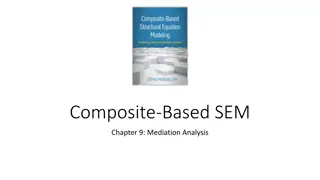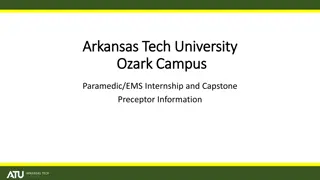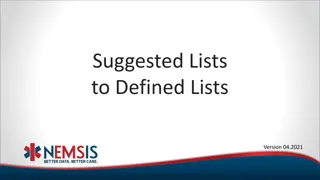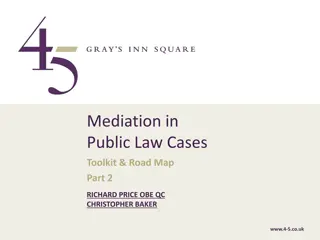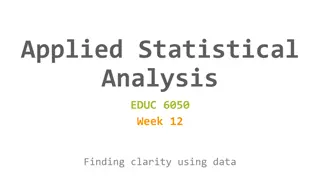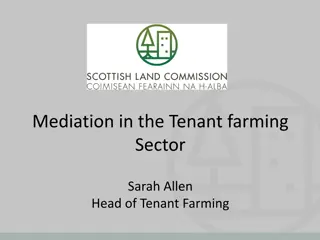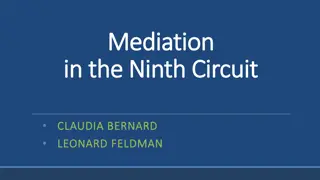
Revised EMS Curriculum & Assessment Plans for Grades 7-9
Explore the revised curriculum and assessment plans for EMS (Economic Management Sciences) in Grades 7-9 to facilitate implementation in June 2020. The purpose is to guide teachers in mediating amendments, covering essential content, and preparing learners effectively. The adjustments include amendments to the content overview, annual teaching plan, and school-based assessments, ensuring meaningful progress within the revised school calendar.
Download Presentation

Please find below an Image/Link to download the presentation.
The content on the website is provided AS IS for your information and personal use only. It may not be sold, licensed, or shared on other websites without obtaining consent from the author. If you encounter any issues during the download, it is possible that the publisher has removed the file from their server.
You are allowed to download the files provided on this website for personal or commercial use, subject to the condition that they are used lawfully. All files are the property of their respective owners.
The content on the website is provided AS IS for your information and personal use only. It may not be sold, licensed, or shared on other websites without obtaining consent from the author.
E N D
Presentation Transcript
2020 REVISED CURRICULUM AND ASSESSMENT PLANS EMS GRADE 7 9 Implementation: June 2020
Presentation Outline 1.Purpose 2.Amendments to the Content Overview for the Phase; 3.Amendments to the Annual Teaching Plan; 4.Amendments School Based Assessment (SBA) 5.Conclusion
1. Purpose To mediate the amendments of the trimmed and re-organised 2020 Annual Teaching Plan including School Based Assessment for EMS, Grade 7 9, for implementation in June 2020 as stipulated in Circular S2 of 2020. To ensure that meaningful proceeds during the remaining teaching time as per the revised school calendar. To assist teachers with guided pacing and sequencing of curriculum assessment. teaching content and
1. Purpose (continued) To enable teachers to cover the essential core content /skills in each grade within the available time. To assist teachers with planning for the different forms of assessment. To ensure learners are adequately prepared for the subsequent year/s in terms of content, skills, knowledge, attitudes and values
2. Amendments to the Content Overview for the Phase
Summary: Amendments to the Content Overview for the Phase GRADE 7 GRADE 8 GRADE 9 The Economy: The Economy: The Economy: The production process Markets Price theory Trade unions Financial Literacy: Financial Literacy: Financial Literacy: Accounting concepts Income and expenses Budgets Savings Accounting cycle Accounting equation Cash Receipts Journal (CRJ) & Cash Payments Journal (CPJ) General Ledger and Trial Balance (service) Entrepreneurship: Accounting equation Credit transactions: debtors Credit transactions: creditors Transactions: Cash and credit Entrepreneurship: Entrepreneurship: Factors of production Forms of ownership Levels and functions of Management Business plan Businesses The entrepreneur Starting a business
3. Amendments to the Annual Teaching Plan
Summary: Reorganisation of content topics: Grade 7 TERM 2 WEEK 1 TOPIC FINANCIAL LITERACY: ACCOUNTING CONCEPTS CONTENT Revised the work covered in the first term; give learners an overview of work of term 2. 2 FINANCIAL LITERACY: ACCOUNTING CONCEPTS Capital; assets; liability; income; expenses; profit 3 FINANCIAL LITERACY: INCOME & EXPENSES FINANCIAL LITERACY: INCOME & EXPENSES Losses; records; transactions Personal income; personal expenses; types of personal income, Personal statement of net worth budgets; savings; banking; financial 4 5 FINANCIAL LITERACY: INCOME & EXPENSES Business income Business expenses 7 FINANCIAL LITERACY: BUDGETS FINANCIAL LITERACY: BUDGETS Savings and investments 8 Definition of a budget; income; expenditure and business budget
Summary: Reorganisation of content topics: Grade 7 TOPIC CONTENT TERM 3 WEEK 1 ENTREPRENEURSHIP: BUSINESSES ENTREPRENEURSHIP: BUSINESSES Formal and informal businesses 2 Types of businesses Trading, manufacturing and service that are both formal and informal 3 ENTREPRENEURSHIP: BUSINESSES The effect of health epidemics on formal and informal businesses can be mentioned as it is relevant to current epidemic (COVID- 19) 4, 5 ENTREPRENEURSHIP: THE ENTREPRENEUR Definition of an entrepreneur; Characteristics and skills of an entrepreneur 6 ENTREPRENEURSHIP: THE ENTREPRENEUR Entrepreneurial actions of buying, selling, producing and making a profit 7 ENTREPRENEURSHIP: STARTING BUSINESS Needs and wants of consumers 8 ENTREPRENEURSHIP: STARTING BUSINESS SWOT analysis 9 ENTREPRENEURSHIP: STARTING BUSINESS SWOT analysis
Summary: Reorganisation of content topics: Grade 7 THE ECONOMY: THE PRODUCTION PROCESS TERM 4 WEEK 1 TOPIC CONTENT Definition of production; inputs and outputs 2 THE ECONOMY: THE PRODUCTION PROCESS Meaning of economic growth and productivity 3 THE ECONOMY: THE PRODUCTION PROCESS Technology in the production process 4 FINANCIAL LITERACY: SAVINGS FINANCIAL LITERACY: SAVINGS FINANCIAL LITERACY: SAVINGS Revision Controlled Test Personal savings and community saving scheme; 5 Purpose of savings; role of banks 6 Services offered by banks; opening a savings account 7 8 100 marks: 90 minutes
Summary: Reorganisation of content topics: Grade 8 TERM 2 WEEK TOPIC CONTENT 1 Revision Revised the work covered in the first term; give learners an overview of work of term 3
Summary: Reorganisation of content topics: Grade 8 TOPIC CONTENT TERM 3 WEEK 2 FINANCIAL LITERACY: Accounting cycle Transactions, Source documents; subsidiary journals; General Ledger; Trial Balance. Introduction of the Cash Journals of a service business. 3 FINANCIAL LITERACY: Accounting equation Cash transactions (receipts) on the accounting equation. Assets = owner s equity + liability (A = OE + L) 4 FINANCIAL LITERACY: CRJ Concepts of CRJ, formats and uses of the columns in CRJ, source documents used to complete the CRJ, 5 FINANCIAL LITERACY: CRJ FINANCIAL LITERACY: CRJ ENTREPRENEURSHIP: FACTORS OF PRODUCTION Entering of cash transactions in the CRJ and closing off the CRJ 6 Entering of cash transactions in the CRJ and closing off the CRJ 7 Types of factors of production Capital borrowed and own capital; labour unskilled, semi-skilled and skilled labour; role of workers in the business; 8 THE ECONOMY: MARKETS THE ECONOMY: MARKETS Project / Case Study Types of markets- goods and services market 9 Types of markets -factor market (labour and financial markets)- 10 50 Marks
Summary: Reorganisation of content topics: Grade 8 TERM 4 WEEK TOPIC CONTENT 1 FINANCIAL LITERACY: Accounting equation Cash transactions (payments) on the accounting equation 2 FINANCIAL LITERACY: CPJ FINANCIAL LITERACY: CPJ FINANCIAL LITERACY: General Ledger and Trial Balance Concepts of CPJ, formats and uses of the columns in CPJ, source documents used to complete a CPJ Entering of cash transactions in the CPJ and closing off the CPJ, 3 4 Double entry principle Posting of journals (CRJ & CPJ) to General Ledger 5 FINANCIAL LITERACY: General Ledger and Trial Balance Double entry principle Posting of journals (CRJ & CPJ) to General Ledger 6 FINANCIAL LITERACY: General Ledger and Trial Balance Balancing of General Ledger; Preparing of a Trial Balance 7 ENTREPRENEURSHIP: FORMS OF OWNERSHIP Different forms of ownership, Sole traders; partnerships; private and public companies; 8 ENTREPRENEURSHIP: LEVELS AND FUNCTIONS OF MANAGEMENT Different levels of management and management tasks- management tasks such as planning, organizing, leading, and controlling; characteristics of good management 9 Controlled Test 100 Marks
Summary: Reorganisation of content topics: Grade 9 TERM 2 WEEK 1 TOPIC FINANCIAL LITERACY: ACCOUNTING EQUATION FINANCIAL LITERACY: CREDIT TRANSACTIONS CONTENT Accounting equation Effect of the transactions on the accounting equation (credit sales) Credit sales; Debtors; National Credit Act; Accounting cycle; DJ 2 TERM 3 WEEK 3 TOPIC FINANCIAL LITERACY: CREDIT TRANSACTIONS: DEBTORS FINANCIAL LITERACY: CREDIT TRANSACTIONS: DEBTORS FINANCIAL LITERACY: CREDIT TRANSACTIONS: DEBTORS THE ECONOMY: PRICE THEORY THE ECONOMY: PRICE THEORY THE ECONOMY: PRICE THEORY ENTREPRENEURSHIP: BUSINESS PLAN ENTREPRENEURSHIP: BUSINESS PLAN CONTENT Recording of receipts from debtors in the CRJ 4 Posting to the General Ledger 5 Posting to the General Ledger 6 Law of demand schedule and graphical illustration of the demand curve 7 Law of supply schedule and graphical illustration of the supply curve 8 Equilibrium price and quantity; change in quantity demanded; change in quantity supplied Concepts, components and format of a business plan 9 10 SWOT analysis and financial plan
Summary: Reorganisation of content topics: Grade 9 TERM 4 WEEK 1 TOPIC FINANCIAL LITERACY: CREDIT TRANSACTIONS: CREDITORS CONTENT Accounting equation Effect of the transactions on the accounting equation (credit purchases) 2 FINANCIAL LITERACY: CREDIT TRANSACTIONS: CREDITORS Creditors; accounting cycle; recording of transactions in the CJ and recording of payments in the CPJ 34 FINANCIAL LITERACY: CREDIT TRANSACTIONS: CREDITORS Posting to the General Ledger and Creditors ledger 5 FINANCIAL LITERACY: CREDIT TRANSACTIONS: CASH AND CREDIT Cash Receipts Journal; Cash Payments Journal; Debtors Journal; Creditors Journal 6 FINANCIAL LITERACY: CREDIT TRANSACTIONS: CASH AND CREDIT Posting to the General Ledger 7 FINANCIAL LITERACY: CREDIT TRANSACTIONS: CASH AND CREDIT Posting to the Debtors and Creditors Ledger 8 THE ECONOMY: TRADE UNIONS Controlled Test Concept of trade unions, effect of trade unions in businesses 100 Marks
Summary: Amendments to the weighting of content topics GRADE 7 GRADE 8 GRADE 9 The Economy: The production process Sustainable use of resources The effect of productivity on the economic growth; contribution of technology to improving productivity and economic growth The Economy: The Economy: Price theory Increase and decrease in demand; increase and decrease in supply; graphical illustration of the change in demand and the change in supply Financial Literacy: Savings: History of banks; Financial organisations; Financial institutions and organisations promoting entrepreneurship Financial Literacy: Financial Literacy: DAJ and CAJ
GRADE 7 Entrepreneurship: Businesses: advantages and GRADE 8 Entrepreneurship: Factors of production Fair employment practices; natural resources; entrepreneurship; GRADE 9 Entrepreneurship: Sectors of the economy The primary, secondary, and tertiary sector; types of businesses found in the three sectors; the interrelationship of the three sectors; sustainable use of resources and the role of the three sectors as well as skills required in each sector Summary: Amendments to the weighting of content topics disadvantages of formal and informal businesses; the role of formal and informal businesses as producers and consumers remuneration of the factors of production Starting a business: Setting goals; achieving goals; the concept of advertising; media used in advertising; principles of advertising; budget for Entrepreneur s Day; use of recycled material; simple cost calculation variable cost, fixed cost, selling price Entrepreneur s Day Hosting of Entrepreneur s Day; income and expenditure statement Forms of ownership: characteristics; advantages and disadvantages; their role in sustainable job creation; role in sustainable use of natural resources Functions of a business: Administration, purchasing, marketing, finances, Public relations, human resources, production, general management and risk management, characteristics of the business functions; role and importance of the business functions Business plan: Break-even points Levels and functions of Management: Different styles of management autocratic style, permissive or free- reign style (laissez-fair), democratic or participatory style
Summary: Content/Topics Amended: Content/Topics Terms Amendment The production process Sustainable use of resources The effect of productivity on the economic growth; contribution of technology to improving productivity and economic growth Removed in Grade 7 Term 4 Price theory Increase and decrease in demand; increase and decrease in supply; graphical illustration of the change in demand and the change in supply Removed in Grade 9 Term 2 The Economy: 2-4 The Economy: 2-4 Trade unions: Brief historical development of trade unions; the roles and responsibilities of trade unions in SA; contribution of trade unions to sustainable growth and development The Economy: 2-4
Summary: Content/Topics Amended Content/Topics Terms Amendment Budgets: Personal budget: Removed from Grade 7, Term 2 Financial Literacy: 2-4 Savings: History of banks; financial organisations; financial institutions and organisations promoting Entrepreneurship; removed from Grade 7, term 4 Financial Literacy: 2-4 Removed DAJ from Grade 9, term 3 and CAJ from Grade 9, term 3 Financial Literacy: 2-4
Summary: Content/Topics Amended Content/Topics Term Amendment Businesses: advantages and disadvantages of formal and informal businesses; the role of formal and informal businesses as producers and consumers; removed from Grade 7, term 3 Entrepreneurship: 2 - 4 Starting a business: Setting goals; achieving goals; the concept of advertising; media used in advertising; principles of advertising; budget for Entrepreneur s Day; use of recycled material; simple cost calculation variable cost, fixed cost, selling price; removed from Grade 7, term 3 Entrepreneurship: 2 - 4 Entrepreneur s Day Hosting of Entrepreneur s Day; income and expenditure statement; removed from Grade 7, term 3 Entrepreneurship: 2 - 4 Entrepreneurship: Factors of production Fair employment practices; natural resources; entrepreneurship; remuneration of the factors of production; removed from Grade 8, term 2 Entrepreneurship: 2 - 4
Summary: Content/Topics Amended Content /Topics Term Amendment Forms of ownership: characteristics; advantages and disadvantages; their role in sustainable job creation; role in sustainable use of natural resources; removed from Grade 8, term 3 Entrepreneurship: 2 - 4 Levels and functions of Management: Different styles of management autocratic style, permissive or free-reign style (laissez-fair), democratic or participatory style; removed from Grade 8, term 4 Entrepreneurship: 2 - 4 Entrepreneurship: Sectors of the economy The primary, secondary, and tertiary sector; types of businesses found in the three sectors; the interrelationship of the three sectors; sustainable use of resources and the role of the three sectors as well as skills required in each sector; removed from Grade 9, term 2 Entrepreneurship: 2 - 4 Functions of a business: Administration, purchasing, marketing, finances, Public relations, human resources, production, general management and risk management, characteristics of the business functions; role and importance of the business functions; removed from Grade 9, term 3 Entrepreneurship: 2 - 4 Business plan: Break-even points; removed from Grade 9, term 3 Entrepreneurship: 2 - 4
4. Amendments School Based Assessment (SBA)
Summary: Revised Programme of Assessment: Grade 7 Term 1 Term 2 Term 3 Term 4 Assignment/ Poster/ Case Study (50 marks; 60 minutes) Informal test (100 marks; 60 minutes) Individual assignment/ project: Entrepreneurship Total: 50 marks Controlled Test: 100 marks; 90 minutes Controlled Test (50 marks; 60 minutes)
Summary: Revised Programme of Assessment: Grade 8 Term 1 Term 2 Term 3 Term 4 Data Response (50 marks; 60 minutes) Project / Case Study 50 Marks Controlled Test (100 marks: 60 minutes) Controlled Test (50 marks; 60 minutes) Paper 1: Financial Literacy (50 marks) Paper 2: Entrepreneurship & The Economy (50 marks)
Summary: Revised Programme of Assessment: Grade 9 Term 1 Term 2 Term 3 Term 4 Assignment (50 marks; 60 minutes) Project : 50 Marks Controlled Test : 100 Marks Controlled Test (50 marks; 60 minutes)
Summary: Revision Controlled Test Structure Grade 7 Grade 8 Grade 9 Financial literacy: 50 Marks (50% weighting) Paper 1: Financial Literacy: 50 marks Paper 1: Financial Literacy: 50 marks The Economy: 25 Marks (25% weighting) Paper 2: The Economy: 25 marks and Entrepreneurship: 25 marks Paper 2. The Economy 25 marks & Entrepreneurship: 25 marks Entrepreneurship: 25 Marks (25% weighting Controlled Test: 100 marks; 90 minutes Controlled Test: 100 marks; 90 minutes Controlled Test: 100 marks; 90 minutes
Contact Details Name: Ms MK Modiba Department of Basic Education Tel: 012 357 4140 Email: modiba.k@dbe.gov.za






